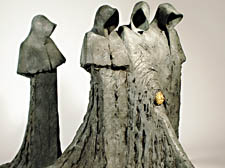|
|
 |
| |

Cloister Conspiracy II (Bronze: H59cm, W48cm, D102cm) |
Mysterious melancholy
Philip Jackson is best known for his Bobby Moore sculpture at Wembley, but there’s a darker side to his work, as Gerald Isaaman discovers
PHILIP Jackson has a split public
personality.The vast majority of people know of him from the colossal double life-size statue of England 1966 World Cup captain Bobby Moore that stands so supreme at the entrance to the new £800 million Wembley Stadium.
But if you want to see the other Jackson, master of mystery, of masked figures with no faces, hooded conspiring clerics in a very different world he calls the Sacred and Profane, then you need to visit the Catto Gallery in Hampstead.
That is where Jackson’s latest exhibition of his more intriguing artistry, fashioned almost organically out of his impressionistic imagination, is now on display.
“There are two definite sides to my work – and, yes, schizophrenia is the word I sometimes use to describe it,” he tells me. “The gallery work at the Catto is far more impressionistic and atmospheric – and deliberately so.
“But then it is aimed at a different audience. You just can’t do something that is going to please everyone. And the public doesn’t necessarily identify me as the same sculptor who does the statues out there on the street. So I do get different kinds of satisfaction out of my work.
“I enjoy doing both enormously. When you’re creating a large public sculpture and standing there on the scaffold, it refreshes you for the gallery sculpture — and vice versa. I’m never at a loss in thinking of images I would like to do in sculpture.”
And he adds: “My sculptures are essentially an impressionistic rendering of the figure. Where you see the figure seemingly grow out of the ground, the texture resembles tree bark, rock or lava flow. And as the eye moves up the sculpture the finish becomes gentler and more delicately worked, culminating in the hands and the mask.”
It is the masked, cloaked figures standing like sentinels – and a passion for decaying Venice – which provide the inspiration for his gallery sculptures, small and large.
He is also interested in the way ecclesiastical dress over the centuries has enabled religion to affect the way we have conducted our lives, the body language of the faceless impacting on our sensitivities.
“I suppose it is the mystery element in mankind,” he suggests. “I am fascinated by the mystery, the elegance and the sense of melancholy that you will find in a place like Venice. So you get this contrast in my work — between the faces of the well known and those without faces whose thoughts are hidden.”
He was at Wembley to see his huge Bobby Moore bronze, packed away for a year while the new stadium was completed, finally unveiled by Moore’s widow Stephanie. And he was there again on Cup Final day last month, modestly mingling with the crowd and standing for a while before the heroic Moore, though not intent on listening to what the fans thought of his efforts.
Indeed, he is a rugby man from Scotland where he was born in 1944, and has earned a remarkable reputation as a sculptor to the Queen, his works appearing in many British cities and as far afield as Switzerland and Argentina.
His equestrian sculpture of the Queen stands in Windsor Great Park and his project on the Queen Mother, as yet to be unveiled, will be in The Mall. His other subjects range from King George V1, a young Mozart, and Constantine the Great at York Minster, to the war hero Raoul Wallenberg, the artist Terence Cuneo at Waterloo Station and the Falklands War sculpture in Portsmouth.
Sport entered his realm when Manchester United commissioned him to do Sir Matt Busby for Old Trafford.
“I was really in two minds whether I wanted to get involved,” he muses. “I wasn’t sure whether I would enjoy working with a football club. But they actually turned out to be the nicest people to deal with, absolutely charming.
“Sometimes one gets involved with a piece of sculpture that is being run by a committee. That can be a nightmare – however many people there are on the committee there are that many opinions. And they will tell you what they think, which you very often don’t want to know.”
The Bobby Moore sculpture came about as a result of a survey of football fans by the FA seeking to find the most iconic figure to represent the beautiful game over the past half century. Fifty per cent of the responses said Bobby Moore.
“He is the figure who sums up what Wembley is all about,” insists Jackson. “It is the home of British football, the home of world football. He is the great iconic figure, the great hero of English football. So he was undoubtedly the right choice.”
|
 |
|
| |
|
 |
|

